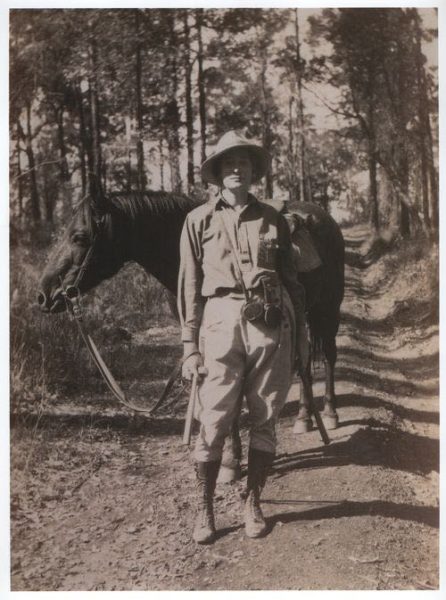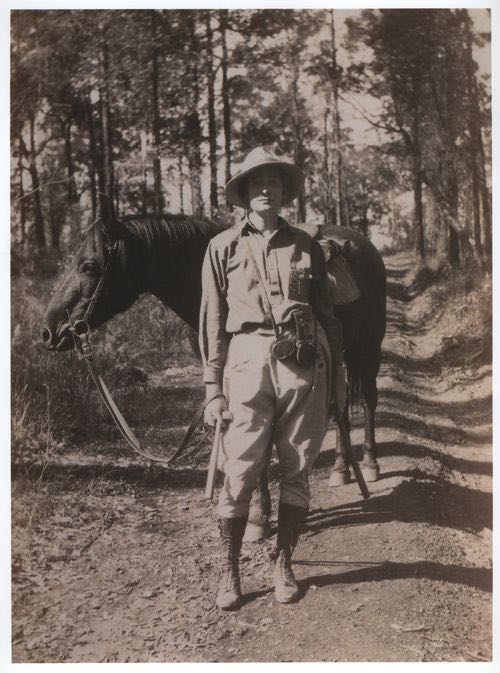Written by Elizabeth Heffernan, RAHS Volunteer
To celebrate Women’s History Month, the Royal Australian Historical Society will highlight Australian women that have contributed to our history in various and meaningful ways. You can browse the women featured on our new webpage, Women’s History Month.
Professor Dorothy Hill is a well-known name in Australia’s scientific circles. The first woman elected president of the Australian Academy of Science, and the first female university professor in Australia, Dorothy lived a fruitful and fulfilling life and career that left its mark upon the fields of geology and palaeontology forever.

Dorothy Hill standing with horse on a geology excursion, 1930 [Image courtesy Fryer Library, University of Queensland Photograph Collection, UQFL466]
Dorothy graduated university with a First Class Honours degree in geology and a prestigious Gold Medal for Outstanding Merit – the first time a woman had ever gained that honour from the University of Queensland. The medal won her a Foundation Travelling Scholarship to the University of Cambridge in 1930. Whilst in England she published a number of papers on the structural patterns of corals which changed the way they were studied by her colleagues. Her contributions were acknowledged by the Old Students’ Research Fellowship of Newnham College, Cambridge, and the Daniel Pidgeon Fund from the Geological Society of London, which she was awarded in 1932 and 1934 respectively. [2]
Returning home in 1937, Dorothy continued her ground-breaking work in coral palaeontology. Her most outstanding contribution during this time was her effort to map the known coral faunas of Australia in order to outline a wide-ranging stratigraphy, from which more comprehensive studies of these corals could be conducted. The criteria developed in her PhD work and used in her studies have since become the standards for coral work around the world.
During the Second World War, Dorothy enlisted in the Women’s Royal Australian Naval Service (WRANS). Her role as an Operations Staff Officer had her deciphering codes, organising shipping safety, and communicating with Australian, American, and British service personnel. Dorothy devoted up to 90 hours a week to her WRANS duties, and at the end of the war served on the Demobilisation Planning Committee. [3]
Dorothy continued her research post-war. She immersed herself in Russian studies on archaeocyathid faunas, fieldwork trips with the Queensland Geological Survey and Bureau of Mineral Resources, and the collation of a comprehensive Geology of Queensland to aid further researchers in her field. In 1946, Dorothy was appointed a lecturer at the University of Queensland, rising through the faculty to become a Professor in 1960. [4] Her work on the Treatise on Invertebrate Palaeontology during this time continues to be consulted in scientific circles today.
Dorothy’s gender was never an obstacle in her career. She became the first female fellow of the Australian Academy of Science in 1956, its first female President in 1970, the first Australian woman to be a fellow of the Royal Society of London in 1964, and the first woman appointed President of the University of Queensland Professorial Board in 1971. Throughout her life she worked tirelessly to promote female enrolment in tertiary science degrees. The Dorothy Hill Medal is today granted to outstanding female researchers in the earth sciences, proving that “previous conventions,” in Dorothy’s words, need not dictate a woman’s chosen life and career. [6]
References:
[1] K. S. W. Campbell and J. S. Jell, ‘Dorothy Hill 1907 – 1997’, Australian Academy of Science, <https://www.science.org.au/fellowship/fellows/biographical-memoirs/dorothy-hill-1907-1997>, accessed 11 March 2019.
[2] Campbell and Jell, ‘Dorothy Hill’.
[3] ‘New WRANS Appointment’, The Argus, 4 October 1944, p. 4.
[4] Dorothy Hill, ‘The first fifty years of the Department of Geology of the University of Queensland’, Papers of the Department of Geology, the University of Queensland 10, no. 1 (1981), pp. 1-68.
[5] ‘Great Queensland women of our past – Dorothy Hill,” Queensland Government, <https://www.qld.gov.au/__data/assets/pdf_file/0019/38611/dorothy-hill-biography.pdf>, accessed 11 March 2019.


0 Comments